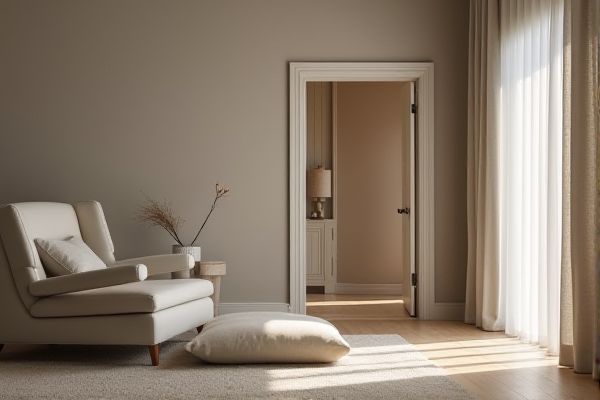
Wall safes offer discreet security by being installed within walls, blending into your home's structure, while floor safes provide enhanced protection due to their heavier, more concealed placement beneath flooring. Discover which option best suits your security needs and lifestyle by reading the rest of the article.
Table of Comparison
| Feature | Wall Safe | Floor Safe |
|---|---|---|
| Installation Location | Mounted inside walls | Installed into floors |
| Security Level | Moderate - concealed but may be less secure | High - harder to detect and remove |
| Accessibility | Easy access at eye or waist level | Requires bending or kneeling |
| Capacity | Generally smaller, limited space | Varies, often larger storage capacity |
| Installation Complexity | Less invasive, easier to install | More invasive, requires floor modification |
| Common Uses | Documents, jewelry, small valuables | Cash, larger valuables, firearms |
Introduction to Wall Safes and Floor Safes
Wall safes offer discreet security by being installed within walls, making them less visible and accessible for safeguarding valuables. Floor safes, embedded into the ground, provide enhanced protection against fire, water, and theft due to their robust construction and hidden placement. Choosing between a wall safe and floor safe depends on your space availability and the level of security you require for your valuables.
Key Differences Between Wall Safes and Floor Safes
Wall safes are typically installed within the wall cavity, offering easier accessibility and discreet concealment behind paintings or furniture. Floor safes provide enhanced security due to their heavier construction and deeper anchoring within concrete floors, making them more resistant to tampering and theft. The choice between wall and floor safes depends on the balance between convenience, security level, and installation space in a given environment.
Security Features: Wall Safe vs Floor Safe
Wall safes typically offer moderate security by blending into walls and using concealed hinges, making them ideal for protecting valuables from casual theft. Floor safes, often constructed from heavy-duty steel with thick walls and bolted into concrete, provide superior resistance against drilling, prying, and fire. Your choice between a wall safe and floor safe depends on the level of protection needed and the type of items you aim to secure.
Installation Process: Wall Safe vs Floor Safe
Wall safes require precise cutting into a wall cavity, often demanding professional help to ensure secure fitting between studs and fireproofing materials. Floor safes involve cutting into concrete or wooden floors, which can be more labor-intensive and may require specialized tools for proper anchoring. Your choice depends on accessibility needs and structural compatibility with your home or office environment.
Accessibility and Convenience Comparison
Wall safes offer easier accessibility and convenience for quick access due to their placement at eye level or within arm's reach, ideal for frequently used items. Floor safes, often installed beneath heavy furniture or carpets, provide enhanced security but require bending down or moving objects, which can reduce immediate accessibility. Depending on your need for speed versus security, selecting the right safe ensures both protection and practicality for your valuables.
Space and Concealment Options
Wall safes offer discreet concealment within walls, making them ideal for limited spaces and keeping valuables hidden behind picture frames or furniture. Floor safes provide deeper security with more storage capacity, often concealed beneath carpets or removable floor panels, perfect for safeguarding larger items. Your choice depends on available space and preferred concealment methods to maximize security and accessibility.
Cost Comparison: Wall Safe vs Floor Safe
Wall safes generally cost less than floor safes due to their smaller size and simpler installation, with prices typically ranging from $100 to $500. Floor safes, designed for higher security and more capacity, often start around $300 and can exceed $1,000 depending on features and materials. Your choice depends on budget constraints and the level of protection needed, as floor safes offer more robust defense against theft despite the higher cost.
Fire and Water Resistance
Wall safes typically offer moderate fire and water resistance, designed to protect valuables from heat and moisture for a limited time. Floor safes often provide higher fire ratings and enhanced water resistance due to their thicker construction and sealing features. Choosing the right option depends on your specific need for safeguarding important documents and valuables against potential fire or flooding hazards.
Best Uses for Wall Safes and Floor Safes
Wall safes are best used for storing important documents, jewelry, and small valuables in discreet locations like behind picture frames or inside closets, offering easy access while saving floor space. Floor safes provide superior protection for larger items such as cash, firearms, or bulky valuables and are ideal for high-security needs due to their heavy construction and ability to be bolted into concrete. Both types offer fire and theft resistance, but floor safes are preferred for long-term storage and higher security situations whereas wall safes suit quick accessibility and lighter protection requirements.
Choosing the Right Safe for Your Needs
Selecting between a wall safe and a floor safe depends on the specific security requirements and installation constraints of your space. Wall safes offer discreet protection ideal for smaller valuables and limited spaces, while floor safes provide superior security through deeper concealment and resistance to theft attempts. Consider the size, accessibility, and structural support of the installation site to ensure maximum effectiveness for preserving valuables.
 homyna.com
homyna.com